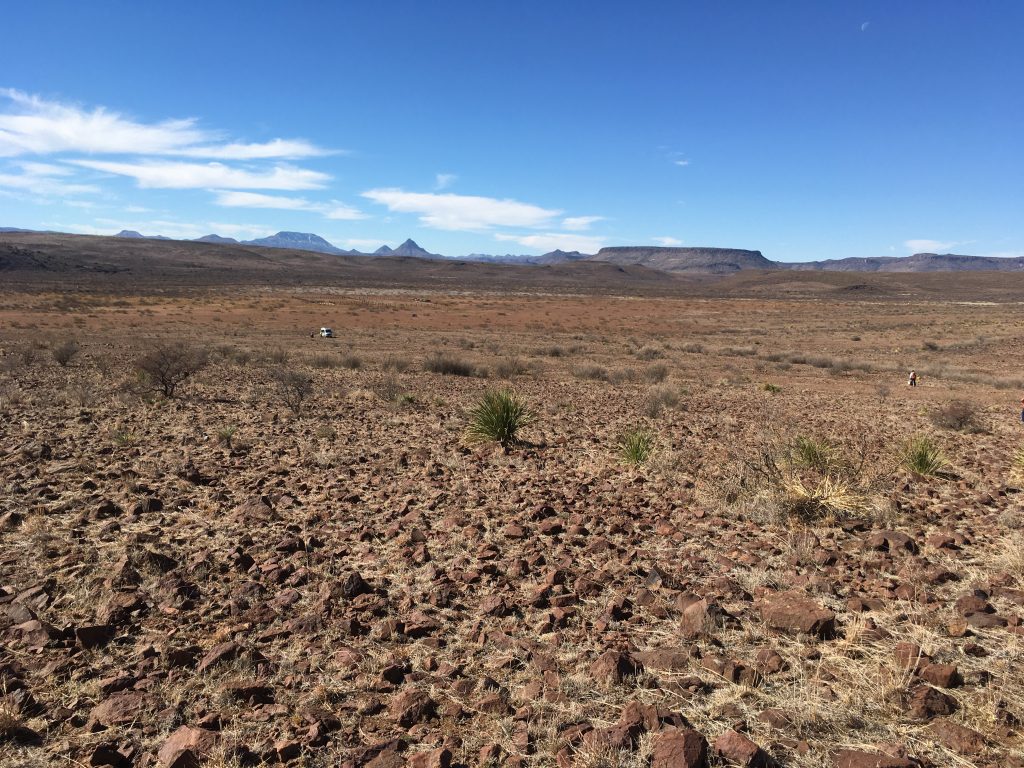
Note: For details about attending one of these incredible hunts, see the note at the end of this post.
| The hunt at the 06 was amazing. We drove north of Alpine on 118 for a ways, out onto the flat valley. We turned right into a dirt road, and drove east on dirt roads for about half an hour. We stopped at a huge valley with a pipe-and-wire corral in the middle of a lovely set of mountains. This was a new place Aaron and James had only hunted once before. The hills were similar in height to the bluffs at the Walker Ranch, and of course steeper in some places than others. There were outcroppings of basalt here and there. There were 9 or so rockhunters on the trip (I believe 10 is the limit) and we were pointed to a hillside about half a mile long. We could fan out enough that we would have not been able to see each another. Aaron & James handed each of us a walkie-talkie to use, and since it’s deer season, we were loaned bright fluorescent vests to wear. At the bottom of the hills, there was a field of rocks about grapefruit to football size. There were agate and quartz crystal pieces in those fields, partly buried in many cases. As you went up the hills, they got rockier, and in some places there was grass stubble between the rocks. Now and then you’d find a patch that had several good sized agates on the surface, and more partially buried. In between those patches were smaller sized agate and quartz crystal pieces and some small nodules that were interestingly colored and otherwise marked on the outside. There were lots of worked pieces and evidence of a native American campsite. We had been advised to go around the campsites when we found them, and although the one I saw was full of broken agate and jasper pieces, there was enough good stuff all over the hills to make it easy to bypass the camp sites. |
|
Some of the agate and jasper there looked
like material from the Ritchie. The dominant agate was
yellow/gold/brown moss in a background of cream, white, or blue
chalcedony. The moss patterns varied from filaments of gold in lacy patterns, to larger patches and islands of moss, to patterns as dense as the flower garden moss from the Walker Ranch. There was enough of it on the surface of the part of that hillside where I was hunting to fill up the beds of several pickups. And the gold moss was ubiquitous: you would go into and out of areas with other types of agate, but you never got far away from the moss agate. |
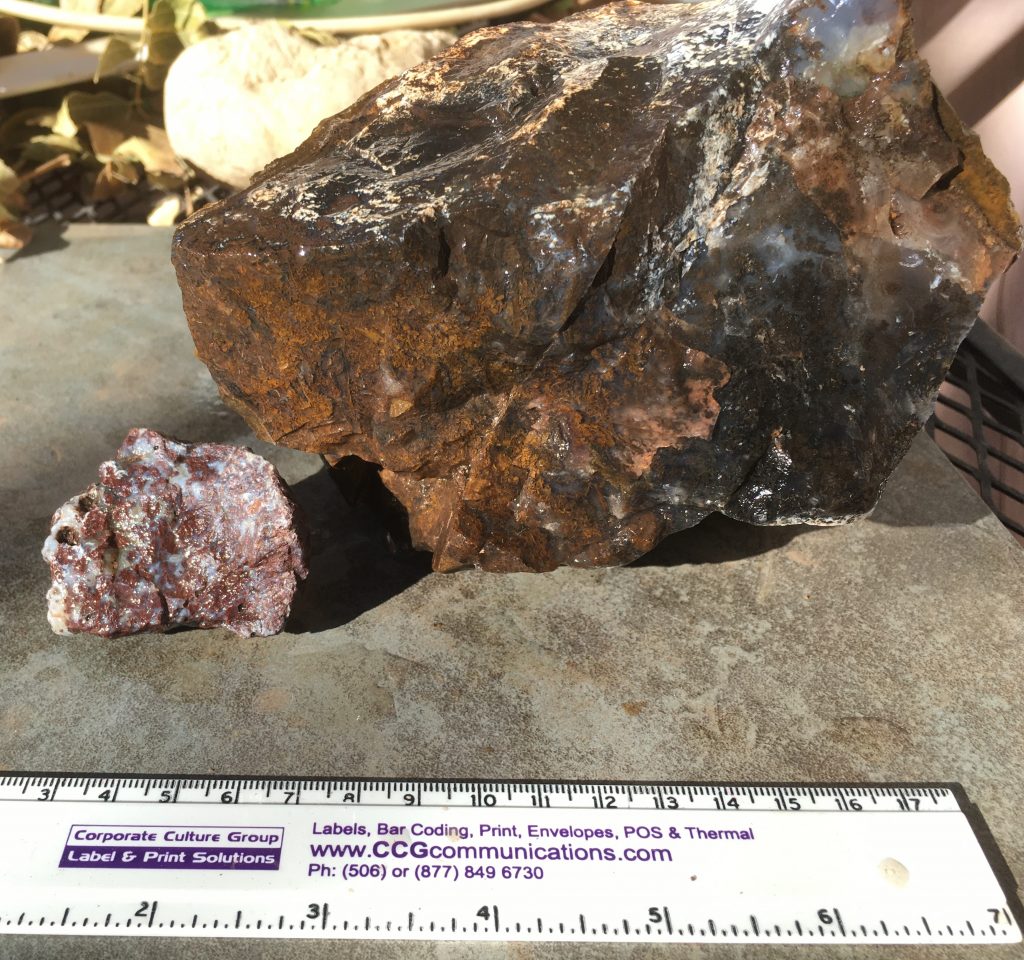
| Along
with the gold moss on that hillside there was red moss, black plume in
cream and blue backgrounds, occasional pieces of red and gold moss, and
some really neat stuff that they call “crayola”. It looks like the
opalized agate that we found on the Ritchie, with much smaller opalized
bits in a chalcedony background, often in a regular pattern. There were
small and big pieces of that, some partly buried and a lot on the
surface. Many had surface pits that were in a regular pattern, as if
there had been filaments of aragonite or another material in the cavity
as the agate formed. Some of the prettiest colors were lavender, maroon
and mauve. I didn’t seen any ‘rind’ on any of the pieces, so they
probably came from a large seam somewhere up the mountain. We had 3 hours there and I probably picked up 100 lbs of what I thought was good material. Aaron wandered around collecting full bags and buckets, which he carried back down to the cars for us. Since I don’t carry a rock hammer, he helped me get a couple of large pieces of the ‘crayola’ agate out of the ground, then carried them down for me. On the way back down to the cars, I followed Aaron to another part of the hill, which was covered with beautiful quartz crystal specimens. I picked up some individual crystals that were at least 3” long, by far the biggest I’ve found on any of the ranches. There were lovely crystal on agate specimens sticking out of the ground everywhere! This was one place where I didn’t mind picking up gold moss agate! I didn’t get to see what everyone else found, so I have no idea what was on the rest of the hill. We got back to the car a bit late, with Aaron carrying all sorts of nice things for me. Everyone else on the trip were people I had taken on fieldtrips, and everyone was excited by what they had found. Some of them were making their second special trip to Alpine from Houston, Schertz and San Antonio to hunt for one exciting day. |
|
Then we drove back the way we’d come for a
while, and took a different branch of one of the roads. In about 20
minutes we were at an area that was the other side of the mountain we
had hunted before. The valley we were in now was not very wide, and
there was supposed to be good agate basically everywhere. There was a dry creek in the bottom of the valley, and since I was looking for the ladies’ room, I wandered into the brush in the creekbed. There were a lot of large pieces of blue chalcedony, some quite vivid, with gold moss or plume in them. There were different colors of blue and grey in fortification patterns or bands, and one had a red coating inside, all over the botryoidal surface, but only on the surface. I found several nice pieces of tube agate: one was blue with blue quartz crystals on the outside of the tubes, another was blue with black and grey fortification lines at the ends of tubes and then around several tubes. That one had gold moss that looked like it was in the middle of the tubes on one side that was broken obliquely to the pattern. There were also several small pieces that were spectacular! |
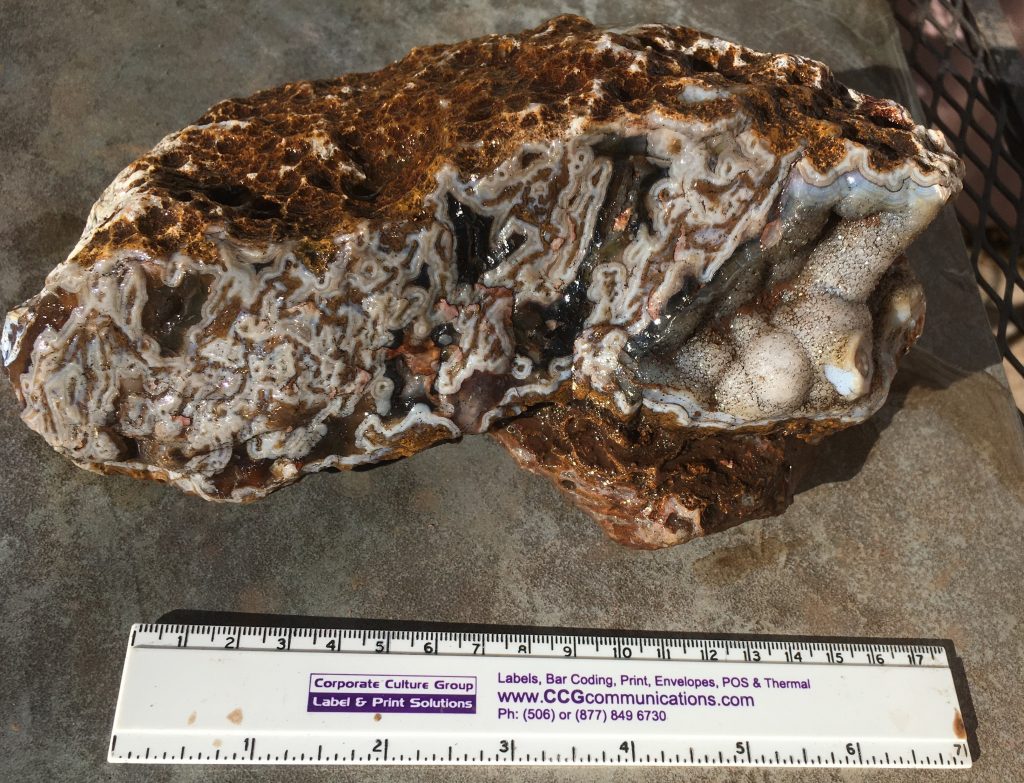
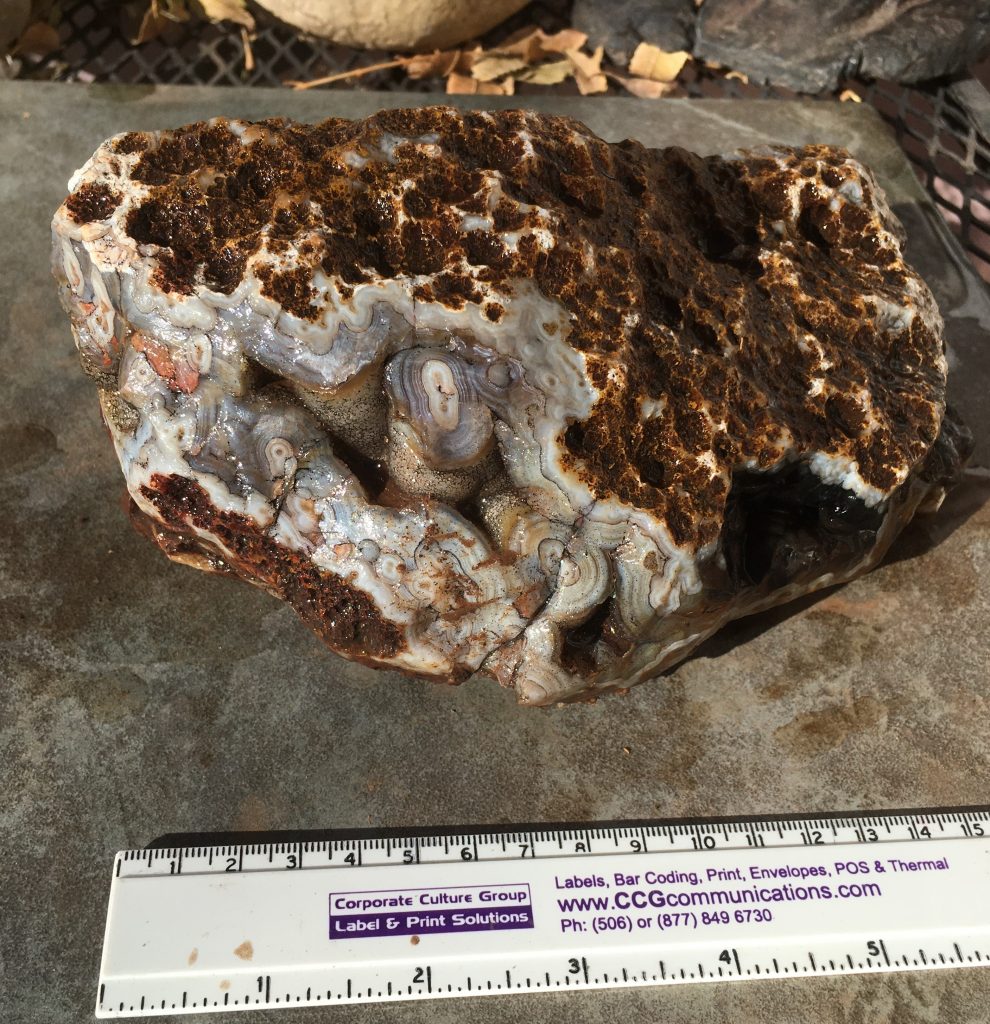
Although there was supposed to be agate up on both hillsides of the little valley, I never got very far up the hills. I stayed in the creek bed for a while, then ventured only a little ways up each hillside. On one hillside I found several large nodules (the size of one of Johnny’s croissant sandwiches) that were orange or yellow chalcedony throughout and really big compared to the ones I found at the Ritchie and the Walker. I also found some pieces off a large seam agate that had a dense pattern that included red, blue, black grey and gold, and appears to have some plume in it.
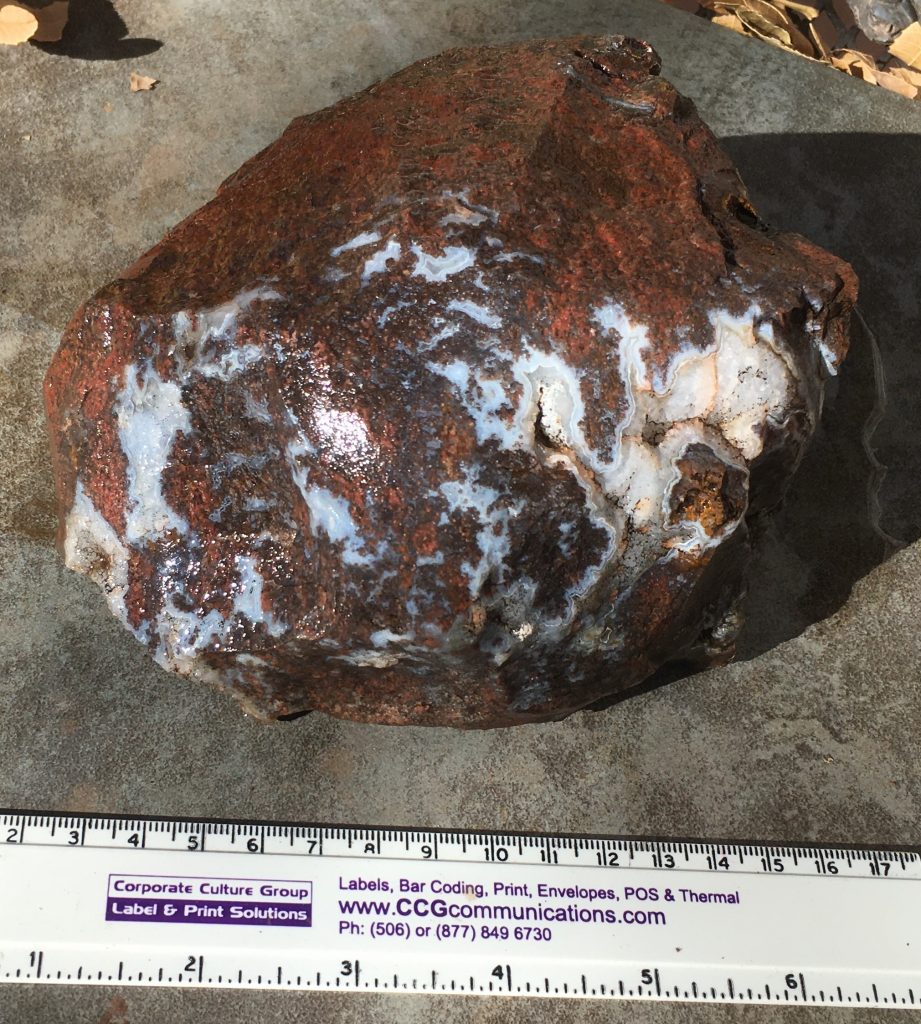
It was there that I came across the only annoyance of the day, in the
form of an individual bee that wanted me to turn around and leave. The
bee hovered around my face and hands for several minutes until I got the
hint. Since I’m really allergic to bee stings, I took his advice and
wandered away from there. Full grown human: 0, Bee: 1.
The other hillside had some blue botryoidal pieces with crystals, a
couple of nice red moss pieces, and my trip rock: a long, narrow nodule
of tube agate with the edges broken off in several places. The
chalcedony at the outer edge of the nodule was stained yellow and
orange., and only part of the nodule was filled in around the tubes. In
the lower part of the nodule, which was solid, there were filaments of
pink that went to maroon and gold. The other end of the nodule was
quartz crystal covered tubes.
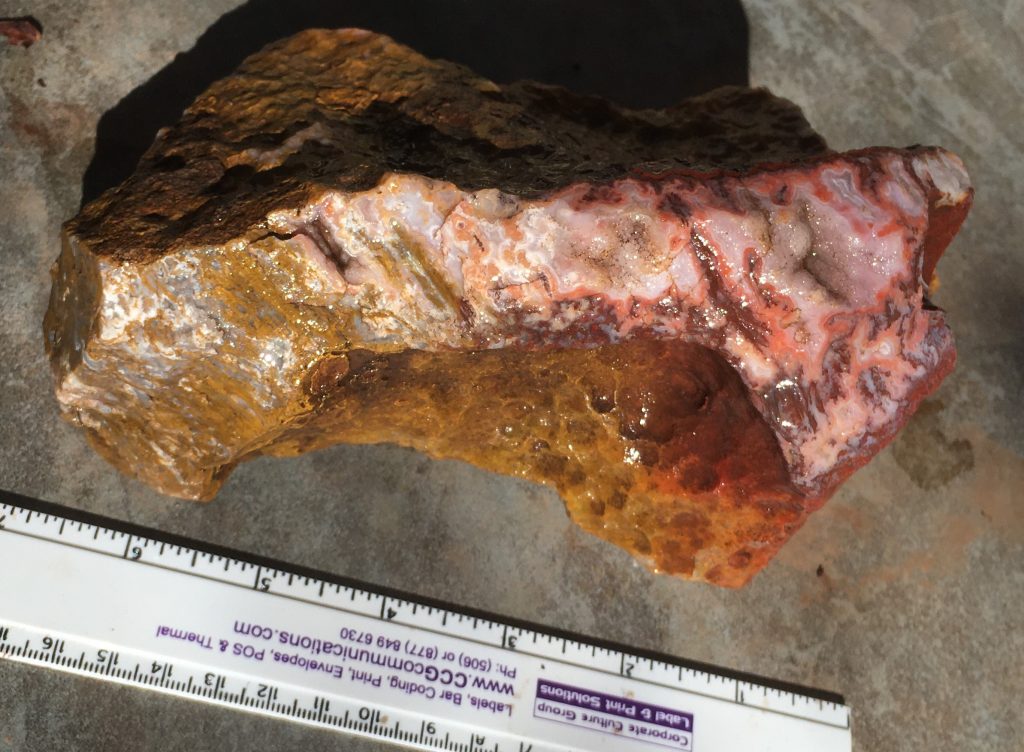
We hunted there for another 3 hours, got back to the cars at 5 p.m., and
the rocks were weighed up. I had 153 lbs., which included a very large
piece of gold moss that was covered on one side with quartz crystals.
If it weren’t for the help of Aaron and James in carrying my rocks back
to the vehicle, I wouldn’t have gotten a third as much.
Today as I was washing the rocks and sorting them, I’ve found about 10
lbs. that, in retrospect, I should have left there. But first thing in
the morning you don’t know what you’ll find later, and when you’re
finding good stuff and having it carried back to the car for you, you
don’t take much time to high grade.
My total adventure cost $213: $60 entrance fee and $153 for rocks. Was
it worth it? Oh yes! It was exhilarating, hunting on ground that had
not been hunted much before. It will be years before that particular
hill runs out of large pieces, and there are hundreds and hundreds of
hills on that ranch. Aaron and James and the other guys that were there
to help dig and carry were helpful and nice. Aaron explained a bit of
the geology to us before we started in the morning, and told us where we
should find better material. I’ll admit I didn’t understand much of
the geological information he was telling us, but his advice on where to
find the good stuff was similar to what we had been practicing on the
Walker, Singleton and other ranches. And the good stuff was indeed
there. I’ve been on a lot of field trips (over 1000 when I quit
counting), and this is one I’ll remember for many years. I’m going back
again in 2 weeks.
Regards,
Teri
Note: The rockhunts on the 06 Ranch are being led by Aaron Thomas and James Winn VI. They begin at the Tri-La-Bite food trucks in Alpine. They currently happen only on Sundays, and are limited to 10 rockhounds per hunt. As of publication time, all hunts scheduled through 1/31/21 are full, and a new schedule for the Spring will be published in February. Once that schedule is published, I will try to schedule my rockhunts to other ranches (if indeed I am leading any) around the 06 hunts so you can come out to the Big Bend and go on hunts ion 4 different ranches in 4 days. If you have any questions about the hunts, you can reach Aaron Thomas at noraathomas@msn.com or roadcutgeology@yahoo.com
